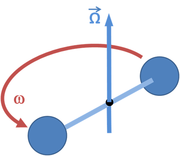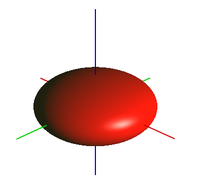- Absolute rotation
-
In physics, the consideration of absolute rotation—rotation independent of any external reference—is a topic of debate about relativity, cosmology, and the nature of physical laws. The question of whether absolute rotation is meaningful is independent of the issue of the existence of absolute time and space.
Contents
Is it meaningful to talk about absolute rotation?
For the concept of absolute rotation to be scientifically meaningful, it must be measurable. In other words, can one decide whether an observed object is rotating or if it is you, the observer that is rotating? Newton suggested two experiments to resolve this problem. One is the effects of centrifugal force upon the shape of the surface of water rotating in a bucket. The second is the effect of centrifugal force upon the tension in a string joining two spheres rotating about their center of mass. A related third suggestion was that rotation of a sphere (such as a planet) could be detected from its shape (or "figure"), which is formed as a balance between containment by gravitational attraction and dispersal by centrifugal force.
Mach's principle
Main article: Mach's principleIn theoretical physics, particularly in discussions of gravitation theories, Mach's principle is the name given by Einstein to a hypothesis often credited to the physicist and philosopher Ernst Mach.
The idea is that the local motion of a rotating reference frame is determined by the large-scale distribution of matter in the universe. Mach's principle says that there is a physical law that relates the motion of the distant stars to the local inertial frame. If you see all the stars whirling around you, Mach suggests that there is some physical law which would make it so you would feel a centrifugal force. The principle is often stated in vague ways, like "mass out there influences inertia here".
Rotating bucket
 Figure 1: The interface of two immiscible liquids rotating around a vertical axis is an upward-opening circular paraboloid.
Figure 1: The interface of two immiscible liquids rotating around a vertical axis is an upward-opening circular paraboloid. See also: Bucket argument
See also: Bucket argumentNewton suggested the shape of the surface of the water indicates the presence or absence of absolute rotation relative to the fixed stars: rotating water has a curved surface, still water has a flat surface. Because rotating water has a concave surface, if the surface you see is concave, and the water does not seem to you to be rotating, then you are rotating with the water.
Centrifugal force is needed to explain the concavity of the water in a co-rotating frame of reference (one that rotates with the water) because the water appears stationary in this frame, and so should have a flat surface. Thus, observers looking at the stationary water need the centrifugal force to explain why the water surface is concave and not flat. The centrifugal force pushes the water toward the sides of the bucket, where it piles up deeper and deeper, Pile-up is arrested when any further climb costs as much work against gravity as is the energy gained from the centrifugal force, which is greater at larger radius.
If you need a centrifugal force to explain what you see, then you are rotating. Newton's conclusion was that rotation is absolute.[1]
Other thinkers suggest that pure logic implies only relative rotation makes sense. For example, Bishop Berkeley and Ernst Mach (among others) suggested that it is relative rotation with respect to the fixed stars that matters, and rotation of the fixed stars relative to an object has the same effect as rotation of the object with respect to the fixed stars.[2] Newton's arguments do not settle this issue; his arguments may be viewed, however, as establishing centrifugal force as a basis for an operational definition of what we actually mean by absolute rotation.[3]
Rotating spheres
See also: Rotating spheresNewton also proposed another experiment to measure one's rate of rotation: using the tension in a cord joining two spheres rotating about their center of mass. Non-zero tension in the string indicates rotation of the spheres, whether or not the observer thinks they are rotating. This experiment is simpler than the bucket experiment in principle, because it need not involve gravity.
Beyond a simple "yes or no" answer to rotation, one may actually calculate one's rotation. To do that, one takes one's measured rate of rotation of the spheres and computes the tension appropriate to this observed rate. This calculated tension then is compared to the measured tension. If the two agree, one is in a stationary (non-rotating) frame. If the two do not agree, to obtain agreement, one must include a centrifugal force in the tension calculation; for example, if the spheres appear to be stationary, but the tension is non-zero, the entire tension is due to centrifugal force. From the necessary centrifugal force, one can determine one's speed of rotation; for example, if the calculated tension is greater than measured, one is rotating in the sense opposite to the spheres, and the larger the discrepancy the faster this rotation.
The tension in the wire is the required centripetal force to sustain the rotation. What is experienced by the physically rotating observer is the centripetal force and the physical effect arising from his own inertia. The effect arising from inertia is referred to as reactive centrifugal force.
Whether or not the effects from inertia are attributed to a fictitious centrifugal force is a matter of choice.
Figure of the Earth
See also: Clairaut's theorem and Figure of the EarthIn a similar fashion, if we did not know the Earth rotates about its axis, we could infer this rotation from the centrifugal force needed to account for the bulging observed at its equator.[4][5]
In his Principia, Newton proposed the shape of the rotating Earth was that of a homogeneous ellipsoid formed by an equilibrium between the gravitational force holding it together and the centrifugal force pulling it apart. The Earth's surface is an equipotential, that is, no work is done moving upon the Earth's surface, either against gravity or against centrifugal force. Based upon this equilibrium, Newton determined a flattening expressed by the ratio of diameters: 230 to 229.[6][7] A modern measurement of the Earth's oblateness leads to an equatorial radius of 6378.14 km and a polar radius of 6356.77 km,[8] about 1/10% less oblate than Newton's estimate.[9] A theoretical determination of the precise extent of oblateness in response to a centrifugal force requires an understanding of the make-up of the planet, not only today but during its formation.[10][11]
This effect is more easily seen with the planet Saturn which has a radius 8.5 to 9.5 times that of Earth but has a rotational period of only 10.57 hours. The ratios of Saturn's diameters is approximately 11 to 10.
Sagnac Experiment
The experiments suggested by Newton are too imprecise to measure an absolute rotation, if any, of the Earth. French physicist Georges Sagnac conducted an experiment that was similar to the Michelson–Morley experiment, but was intended to observe the effects of rotation. Sagnac experiment and later similar experiments showed that a stationary object on the surface of the Earth will rotate once every rotation of the Earth when using stars as a stationary reference point. Rotation was thus concluded to be absolute rather than relative.
References
- ^ Max Born and Günther Leibfried. Einstein's Theory of Relativity. Courier Dover Publications. p. 78–79. ISBN 0-486-60769-0. http://books.google.com/books?id=Afeff9XNwgoC&pg=PA76&dq=inertial+forces.
- ^ BK Ridley (1995). Time, Space, and Things (3 ed.). Cambridge University Press. p. 146. ISBN 0-521-48486-3. http://books.google.com/books?id=_kgYo4Sk9_kC&pg=PA146.
- ^ Rather than justifying a causal link between rotation and centrifugal effects, Newton's arguments may be viewed as defining "absolute rotation" by stating a procedure for its detection and measurement involving centrifugal force. See Robert Disalle (2002). I. Bernard Cohen & George E. Smith. ed. The Cambridge Companion to Newton. Cambridge University Press. pp. 44–45. ISBN 0-521-65696-6. http://books.google.com/books?id=3wIzvqzfUXkC&pg=PA43#PPA44,M1.
- ^ Archibald Tucker Ritchie (1850). The Dynamical Theory of the Formation of the Earth. Longman, Brown, Green and Longmans. p. 529. http://books.google.com/books?id=YGdDAAAAIAAJ&pg=RA1-PA529.
- ^ John Clayton Taylor (2001). Hidden unity in nature's laws. Cambridge University Press. p. 26. ISBN 0-521-65938-8. http://books.google.com/books?id=VEn8Orko4FgC&pg=PA26.
- ^ Isaac Newton: Principia (July 5, 1687) Book III Proposition XIX Problem III, p. 407 in Andrew Motte translation.
- ^ See the Principia on line at Andrew Motte Translation. Other sources and some notes are found at Philosophiæ Naturalis Principia Mathematica.
- ^ Charles D Brown (1998). Spacecraft mission design (2 ed.). American Institute of Aeronautics & Astronomy. p. 58. ISBN 1-56347-262-7. http://books.google.com/books?id=vpilMLP7OHQC&pg=PA57.
- ^ This error is the difference in the estimated ratio of diameters. However, a more demanding measure of oblateness is the flattening, defined as f = (a−b)/a where a and b are the semimajor and semiminor axes. Using the cited numbers, the flattening of Newton's prediction differs by 23% from that of modern estimates.
- ^ Hugh Murray (1837). "Figure and constitution of the Earth deduced from the theory of gravitation". The Encyclopædia of Geography. vol. 1. Carey, Lea & Blanchard. pp. 124 ff. http://books.google.com/books?id=sFYWAAAAYAAJ&pg=PA125.
- ^ Alexander Winchell (1888). World-life; Or, Comparative Geology. SC Griggs & Co.. p. 425. http://books.google.com/books?id=cctLAAAAMAAJ&pg=PA426.
See also
Wikimedia Foundation. 2010.


